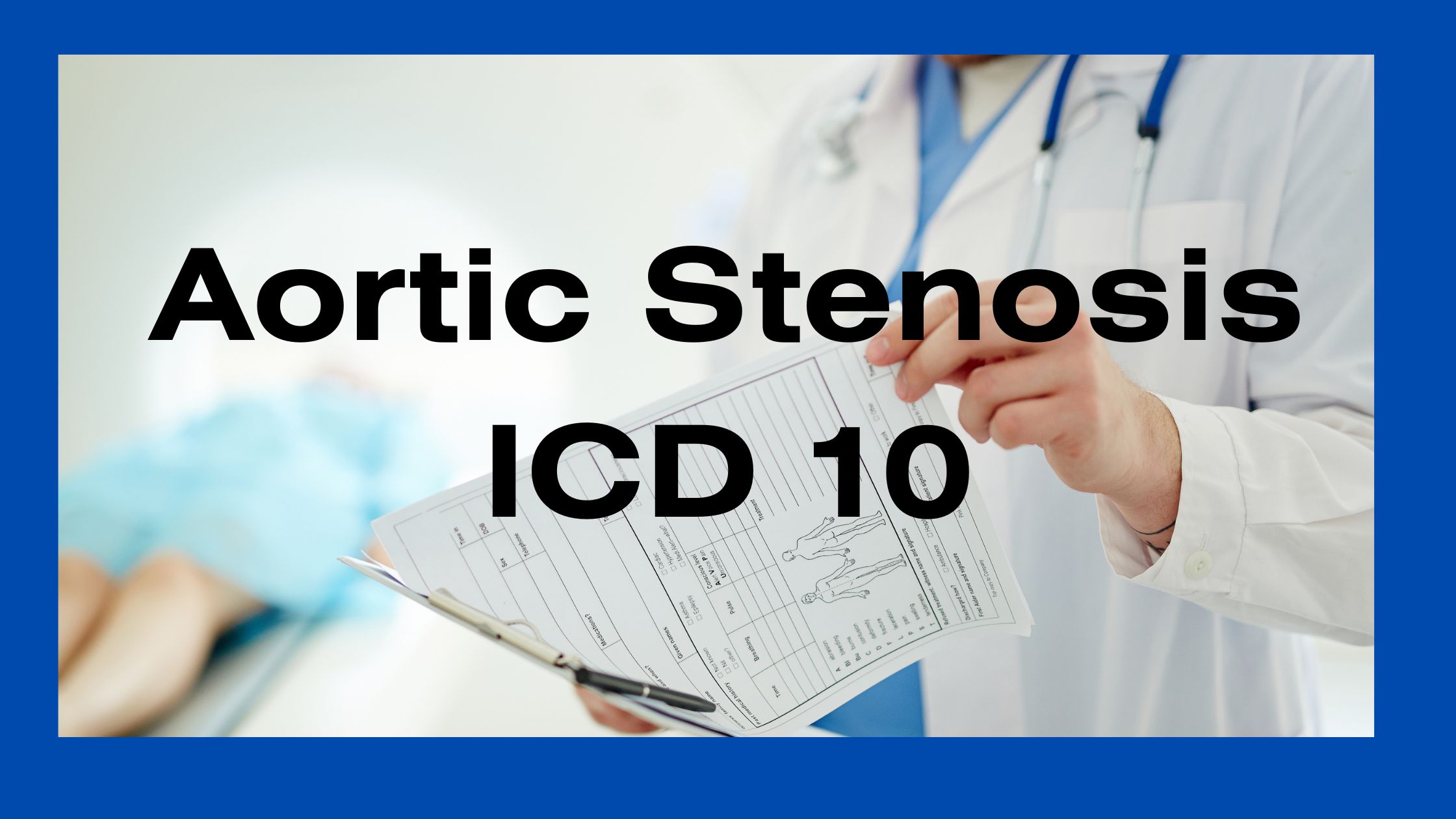Aortic stenosis is a cardiovascular condition characterized by the narrowing of the aortic valve opening, which restricts blood flow from the left ventricle to the aorta. It is crucial to have an accurate and standardized way of classifying and documenting this condition for medical purposes. In the International Classification of Diseases, Tenth Revision (ICD-10), a specific code, I35.0, is assigned to aortic stenosis. This article will delve into the details of aortic stenosis, including its causes, symptoms, diagnosis, and treatment options.
List of Related Aortic Stenosis ICD 10 codes
- I33.9 Acute and subacute endocarditis, unspecified:
- This code represents cases of endocarditis, which is the inflammation of the inner lining of the heart chambers and valves. It is categorized as “unspecified,” meaning the specific type or cause of endocarditis is not specified.
- I34 Nonrheumatic mitral valve disorders:
- This code is a general category for nonrheumatic disorders of the mitral valve, which is one of the heart’s four valves. These disorders are not caused by rheumatic fever.
- I34.0 Nonrheumatic mitral (valve) insufficiency:
- This code is used to indicate the presence of mitral valve insufficiency, also known as mitral regurgitation, where the mitral valve doesn’t close properly, leading to the backward flow of blood in the heart.
- I34.1 Nonrheumatic mitral (valve) prolapse:
- This code is used when a patient has mitral valve prolapse, a condition in which the mitral valve bulges into the left atrium during the heart’s contraction.
- I34.2 Nonrheumatic mitral (valve) stenosis:
- This code is used for cases of mitral valve stenosis, a condition where the mitral valve narrows, restricting blood flow from the left atrium to the left ventricle.
- I34.8 Other nonrheumatic mitral valve disorders:
- This code encompasses nonrheumatic mitral valve disorders that do not fall into the specific categories mentioned earlier.
- I34.81 Nonrheumatic mitral (valve) annulus calcification:
- This code is used when there is calcification (hardening) of the mitral valve annulus, which is the ring-like structure that supports the mitral valve.
- I34.89 Other nonrheumatic mitral valve disorders:
- Similar to I34.8, this code covers nonrheumatic mitral valve disorders that don’t fit into the previously mentioned subcategories.
- I34.9 Nonrheumatic mitral valve disorder, unspecified:
- This code is used when a nonrheumatic mitral valve disorder is present, but the specific type or nature of the disorder is not specified.
- I35 Nonrheumatic aortic valve disorders:
- This is a general category for nonrheumatic disorders of the aortic valve, another one of the heart’s four valves.
- I35.0 Nonrheumatic aortic (valve) stenosis:
- This code indicates the presence of aortic valve stenosis, a condition where the aortic valve narrows, impeding the flow of blood from the heart to the aorta.
- I35.1 Nonrheumatic aortic (valve) insufficiency:
- This code is used when there is aortic valve insufficiency, also known as aortic regurgitation, which involves the backflow of blood from the aorta into the left ventricle.
- I35.2 Nonrheumatic aortic (valve) stenosis with insufficiency:
- This code represents cases where both aortic valve stenosis and insufficiency are present in the same patient.
- I35.8 Other nonrheumatic aortic valve disorders:
- This code covers nonrheumatic aortic valve disorders that do not fit into the specific categories mentioned earlier.
- I35.9 Nonrheumatic aortic valve disorder, unspecified:
- Similar to other “unspecified” codes, this is used when a nonrheumatic aortic valve disorder is present, but the specific type or nature of the disorder is not specified.
- I36 Nonrheumatic tricuspid valve disorders:
- This is a general category for nonrheumatic disorders of the tricuspid valve, one of the heart’s four valves.
- I36.0 Nonrheumatic tricuspid (valve) stenosis:
- This code is used to indicate the presence of tricuspid valve stenosis, a condition where the tricuspid valve narrows, hindering blood flow from the right atrium to the right ventricle.
- I36.1 Nonrheumatic tricuspid (valve) insufficiency:
- This code represents cases of tricuspid valve insufficiency, where the tricuspid valve doesn’t close properly, allowing the backward flow of blood from the right ventricle to the right atrium.
- I36.2 Nonrheumatic tricuspid (valve) stenosis with insufficiency:
- This code is used when both tricuspid valve stenosis and insufficiency are present in the same patient.
- I36.8 Other nonrheumatic tricuspid valve disorders:
- Similar to other “other” codes, this one covers nonrheumatic tricuspid valve disorders that do not fit into specific subcategories.
- I36.9 Nonrheumatic tricuspid valve disorder, unspecified:
- This code is used when a nonrheumatic tricuspid valve disorder is present, but the specific type or nature of the disorder is not specified.
Causes of Aortic Stenosis:
Aortic stenosis can have various causes, including:
1. Congenital Heart Defects: Some individuals are born with aortic stenosis, either due to a faulty valve structure or abnormal valve leaflets. These defects can restrict the normal flow of blood through the valve and lead to the development of aortic stenosis.
2. Age-related Degeneration: The most common cause of aortic stenosis in adults is the degeneration of the valve over time. This degeneration occurs due to the gradual buildup of calcium on the valve leaflets, resulting in their thickening and reduced flexibility. As a result, the valve becomes narrowed and obstructs the blood flow.
3. Rheumatic Fever: A complication of untreated strep throat infection, rheumatic fever can lead to scarring and damage to the aortic valve. Over time, this scarring can cause the valve to become narrow, resulting in aortic stenosis.
Symptoms of Aortic Stenosis:
The symptoms of aortic stenosis may vary depending on the severity of the condition. Some common symptoms include:
1. Chest Pain or Tightness: Individuals with aortic stenosis may experience chest pain or discomfort, often described as a tightness or pressure sensation. This pain can be a result of the heart not receiving enough oxygen-rich blood due to the narrowed valve.
2. Shortness of Breath: As the heart struggles to pump blood efficiently through the narrowed valve, it may result in shortness of breath, especially during physical exertion or when lying down. The reduced blood supply to the body can lead to inadequate oxygenation, causing breathlessness.
3. Fatigue: Reduced blood flow to the body can cause fatigue or generalized weakness. The heart has to work harder to overcome the narrowed valve, which can result in increased fatigue and a decreased ability to perform daily activities.
4. Fainting or Dizziness: In severe cases, aortic stenosis may lead to fainting spells or dizziness, especially during physical activity. This occurs due to inadequate blood supply reaching the brain, causing a temporary loss of consciousness.
5. Heart Murmur: Healthcare professionals often detect a heart murmur, an abnormal sound during a stethoscope examination, which may indicate aortic stenosis. The murmur is produced by the turbulent blood flow across the narrowed valve.
Diagnosis of Aortic Stenosis:
To diagnose aortic stenosis and assign the appropriate ICD-10 code I35.0, healthcare professionals employ various diagnostic methods, including:
1. Physical Examination: During a physical examination, a healthcare provider may listen to the heart using a stethoscope to identify any abnormal sounds or murmurs. The presence of a heart murmur may suggest the possibility of aortic stenosis.
2. Echocardiogram: An echocardiogram is a non-invasive imaging test that uses sound waves to produce images of the heart. It helps evaluate the structure and function of the heart valves, including the aortic valve. It can provide detailed information about the severity and extent of aortic stenosis.
3. Electrocardiogram (ECG): An ECG records the electrical activity of the heart and can help identify any abnormal rhythms or signs of strain. It may show changes that suggest the presence of aortic stenosis or associated complications.
4. Cardiac Catheterization: In some cases, cardiac catheterization may be performed to obtain more detailed information about the severity of aortic stenosis. It involves inserting a catheter into the blood vessels and injecting a contrast dye to visualize the aortic valve and surrounding structures. This procedure helps determine the precise location and extent of the stenosis.
Treatment of Aortic Stenosis:
The treatment options for aortic stenosis vary depending on the severity of the condition, symptoms experienced, and the individual’s overall health. Some potential treatment approaches include:
1. Medications: Medications may be prescribed to manage symptoms associated with aortic stenosis, such as high blood pressure or heart failure. However, they cannot reverse the narrowing of the aortic valve. These medications aim to improve symptoms and slow down disease progression.
2. Valve Repair or Replacement: In severe cases of aortic stenosis, surgical intervention may be necessary to repair or replace the damaged valve. This can be done either through traditional open-heart surgery or minimally invasive procedures, such as transcatheter aortic valve replacement (TAVR). Valve repair or replacement aims to restore normal blood flow through the aortic valve and relieve symptoms.
3. Balloon Valvuloplasty: In some cases, a balloon catheter may be used to temporarily widen the narrowed aortic valve, relieving symptoms. However, this procedure is often considered a temporary solution and may not provide long-term benefits. It can be an option for individuals who are not suitable candidates for surgery or as a bridge to valve replacement.
4. Lifestyle Modifications: Individuals with aortic stenosis can benefit from adopting a heart-healthy lifestyle, including regular exercise, a balanced diet, smoking cessation, and maintaining a healthy weight. These modifications can help improve overall cardiovascular health and manage associated risk factors.
Conclusion:
Aortic stenosis is a significant cardiovascular condition that requires accurate coding and documentation for effective medical management. The ICD-10 code I35.0 specifically addresses aortic stenosis, enabling healthcare providers to track and classify cases accurately. By understanding the causes, symptoms, diagnosis, and treatment options associated with aortic stenosis, individuals can seek timely medical interventions, leading to improved outcomes and a better quality of life. If you suspect any symptoms related to aortic stenosis, consult a healthcare professional for appropriate evaluation and management. Early detection and appropriate treatment are key to managing this condition effectively.
FAQ
Ans. Aortic stenosis is a cardiovascular condition characterized by the narrowing of the aortic valve opening, which restricts blood flow from the left ventricle to the aorta.
Ans. Aortic stenosis can be caused by congenital heart defects, age-related degeneration, and rheumatic fever.
Ans. Symptoms of aortic stenosis may include chest pain or tightness, shortness of breath, fatigue, fainting or dizziness, and the presence of a heart murmur.
Ans. Aortic stenosis is diagnosed through physical examination, echocardiogram, electrocardiogram (ECG), and cardiac catheterization.
Related Articles:
List of Diagnosis Related Groups |What is DRG Code


